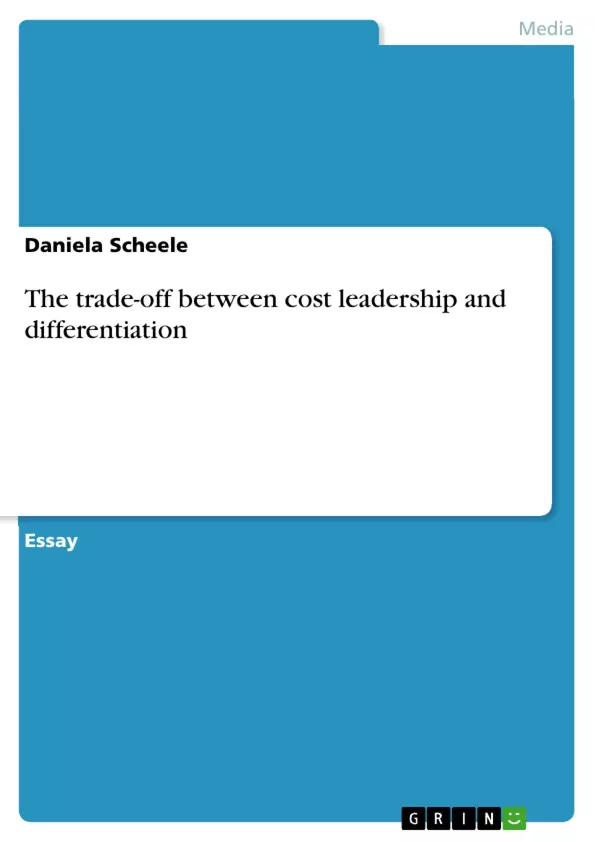´Porter is considered by many as the most influential strategist in the field of business-strategy. His three generic strategies introduced in 1980 has become a dominant paradigm in business policy literature and has had a deep and pervasive influence on the way of thinking in strategy formulation.
The development of a competitive strategy is the search for a favourable competitive position in an industry, aiming to establish a profitable and sustainable competitive advantage over its rivals by choosing activities that are superior in a way that is of value to customers (Porter, 1985; Porter, 1996).
In order to formulate an overall strategy and to understand a firm’s environment as well as to achieve a competitive advantage to outperform rivals in the industry, a company has to apply two frameworks: Porter’s five forces of suppliers, buyers, potential entrants, substitutes and rivalry is a means to define the sustainability and long-term profitability of one industry versus others and thus help to understand the industry attractiveness. The three generic strategies namely cost leadership, differentiation and focus strategy as the second framework provide the context for the actions to be taken into account to achieve a superior performance. Hence, they should be an essential component in any firm’s strategic plan (Porter, 1980; Porter, 1985; Porter, 1996).
Table of Contents
- Introduction
- Generic Strategies for Achieving Competitive Advantage
- Cost Leadership Strategy
- Differentiation Strategy
- Cost Leadership and Differentiation Strategy
- Are Cost Leadership and Differentiation Strategies Mutually Exclusive?
- The Trade-off Between Cost Leadership and Differentiation Strategies
- Conclusion
Objectives and Key Themes
This paper aims to examine the debate in the academic literature about whether cost leadership and differentiation strategies are mutually exclusive as business strategies. It specifically explores the opposing perspectives of "Porter's school of thought" and the "opposing school."
- Competitive Advantage and Generic Strategies
- Cost Leadership Strategy and its Implementation
- Differentiation Strategy and its Implementation
- The Trade-off Between Cost Leadership and Differentiation
- The "Porter's School of Thought" vs. the "Opposing School"
Chapter Summaries
- Introduction: This section introduces the concept of generic strategies, highlighting their importance in formulating a competitive advantage. It mentions Porter's three generic strategies and their influence on business strategy literature.
- Generic Strategies for Achieving Competitive Advantage: This chapter outlines the three generic strategies proposed by Porter: cost leadership, differentiation, and focus strategy. It discusses their role in achieving superior performance and their importance in strategic planning.
- Cost Leadership Strategy: This chapter focuses on the cost leadership strategy, explaining its core objective of achieving the lowest cost compared to competitors. It highlights the importance of producing a standardized product at low per-unit costs, emphasizing its appeal to price-sensitive buyers.
- Differentiation Strategy: This chapter delves into the differentiation strategy, emphasizing the creation of a unique product or service that stands out from competitors. It explores different aspects of differentiation, including product innovation, intensive marketing, and image management.
- Cost Leadership and Differentiation Strategy: This chapter examines the application of both cost leadership and differentiation strategies, noting that they are often adopted by larger businesses with access to the necessary resources. It highlights the suitability of differentiation in dynamic markets and cost leadership in stable environments.
- Are Cost Leadership and Differentiation Strategies Mutually Exclusive?: This chapter explores the central debate surrounding the relationship between cost leadership and differentiation strategies. It presents both "Porter's school of thought," which argues for their exclusivity, and the "opposing school," which advocates for their potential coexistence.
- The Trade-off Between Cost Leadership and Differentiation Strategies: This section delves into the potential trade-off between cost leadership and differentiation. It discusses how a firm's focus on one strategy might necessitate sacrifices in the other, highlighting the challenge of balancing these two approaches.
Keywords
This paper focuses on key concepts within the field of strategic management, exploring the relationship between cost leadership and differentiation as competitive strategies. These concepts include generic strategies, competitive advantage, industry analysis, value chain, and the trade-offs associated with pursuing different strategic approaches. It also explores the "Porter's school of thought" and the "opposing school" perspectives on cost leadership and differentiation, contrasting their views on the mutual exclusivity of these two strategies.
- Quote paper
- Daniela Scheele (Author), 2013, The trade-off between cost leadership and differentiation, Munich, GRIN Verlag, https://www.grin.com/document/268956



